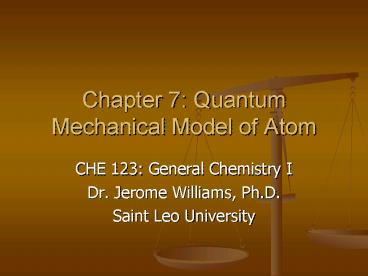Chapter 7: Quantum Mechanical Model of Atom
1 / 21
Title:
Chapter 7: Quantum Mechanical Model of Atom
Description:
Chapter 7: Quantum Mechanical Model of Atom. CHE 123: General Chemistry I ... Bohr - described atom as electrons circling around a nucleus and concluded that ... –
Number of Views:2659
Avg rating:5.0/5.0
Title: Chapter 7: Quantum Mechanical Model of Atom
1
Chapter 7 Quantum Mechanical Model of Atom
- CHE 123 General Chemistry I
- Dr. Jerome Williams, Ph.D.
- Saint Leo University
2
Overview
- Bohr Model of Hydrogen Atom
- Quantum Mechanical Model of Atom
- Quantum Numbers
3
Bohr Model of Hydrogen Atom
- Niels Bohr - described atom as electrons circling
around a nucleus and concluded that electrons
have specific energy levels. - Limited only to Hydrogen atom or Hydrogen like
ion.
4
(No Transcript)
5
Bohr Model of Hydrogen Atom
- Energy levels evaluated using the following
equation - E -2.178 x 10-18 J (Z2 / n2)
- ?E E (final) E (initial) -2.178 x 10-18 J
(1 / nfinal2 1 / ninital2)
6
(No Transcript)
7
(No Transcript)
8
(No Transcript)
9
Quantum Mechanical Model of Atom
- Erwin Schrödinger - proposed quantum mechanical
model of atom, which focuses on wavelike
properties of electrons.
10
Quantum Mechanical Model of Atom
- Werner Heisenberg - showed that it is impossible
to know (or measure) precisely both the position
and velocity (or the momentum) at the same time. - The simple act of seeing an electron would
change its energy and therefore its position.
11
(No Transcript)
12
(No Transcript)
13
Quantum Mechanical Model of Atom
- Erwin Schrödinger - developed a compromise which
calculates both the energy of an electron and the
probability of finding an electron at any point
in the molecule. - This is accomplished by solving the Schrödinger
equation, resulting in the wave function, ?.
14
Quantum Numbers
- Wave functions describe the behavior of
electrons. - Each wave function contains three variables
called quantum numbers - Principal Quantum Number (n)
- Angular-Momentum Quantum Number (l)
- Magnetic Quantum Number (ml)
15
Quantum Numbers
- Principal Quantum Number (n) Defines the size
and energy level of the orbital. n 1, 2, 3,
??? - As n increases, the electrons get farther from
the nucleus. - As n increases, the electrons energy increases.
- Each value of n is generally called a shell.
16
Quantum Numbers
- Angular-Momentum Quantum Number (l) Defines the
three-dimensional shape of the orbital. - For an orbital of principal quantum number n, the
value of l can have an integer value from 0 to n
1. - This gives the subshell notation l 0 s -
orbital l 1 p - orbital l 2 d -
orbital l 3 f - orbital l 4 g - orbital
17
Quantum Numbers
- Magnetic Quantum Number (ml) Defines the spatial
orientation of the orbital. - For orbital of angular-momentum quantum number,
l, the value of ml has integer values from l to
l. - This gives a spatial orientation ofl 0 giving
ml 0 l 1 giving ml 1, 0, 1l 2 giving
ml 2, 1, 0, 1, 2, and so on...
18
(No Transcript)
19
Quantum Numbers
20
Quantum Numbers
- Why cant an electron have the following quantum
numbers? - (a) n 2, l 2, ml 1 (b) n 3, l 0, ml
3 - (c) n 5, l 2, ml 1
- Give orbital notations for electrons with the
following quantum numbers - (a) n 2, l 1, ml 1 (b) n 4, l 3, ml
2 - (c) n 3, l 2, ml 1
21
Quantum Numbers
- Spin Quantum Number (ms)
- The Pauli Exclusion Principle states that no two
electrons can have the same four quantum numbers.































